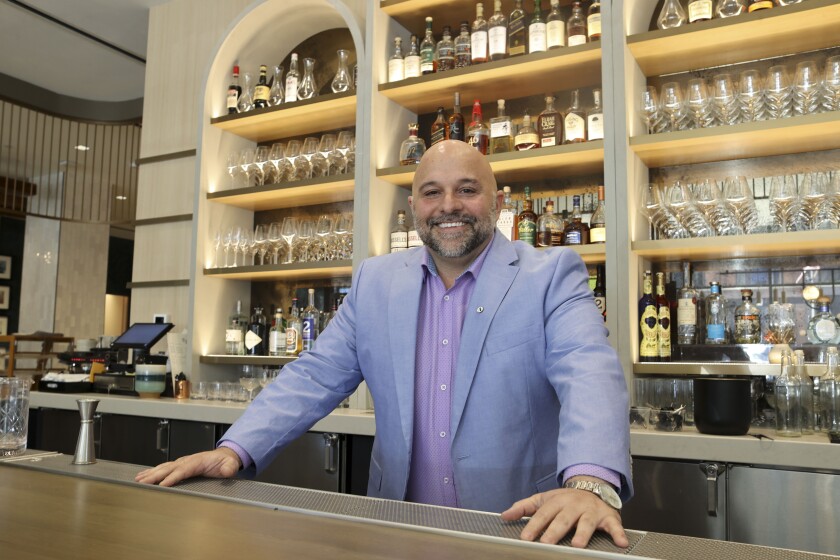FARGO — It might be a howly, growly Christmas for some consumers this holiday after hearing about the potential liquor, wine and beer shortages this holiday season.
Thanks to COVID — the "gift" that keeps on giving — you may have to brave your Great Aunt Violet's hideous holiday gifts with nogless eggs, "nulled" cider and 12-and-under Tom and Jerrys.
ADVERTISEMENT
The sobering trend has been tied to a perfect storm — or maybe a perfect drought — of factors, ranging from escalating consumption among a stressed-out populace to the same supply-chain bottlenecks that have affected dozens of other industries.
Rod Thompson, general manager of and Trax Liquors in Dilworth, Minnesota, says the shortages have become more significant in the last three to four months. "We started noticing that every shipment we get is pretty much short items, due to the lack of product," he says. "Every one of our vendors will say, 'If I had it, I would sell it. It's my livelihood."
Nader Mossavi, food and beverage director at the Rosewild in Fargo's Jasper Hotel, said they've especially felt the pinch in the last month. He's not only seeing 750-ml bottles only available in 375 ml sizes, but finding it can take anywhere from 30 to 40 days for some orders to be delivered.
"I want to let our consumers know it's not us," says Mossavi, who previously worked in Las Vegas for 21 years overseeing food and beverage operations for various casinos. "I want to sell you that $300 bottle of wine ... and I want people to come out and have a good time. But I'm hoping people understand that there's not only a labor shortage, there's a consumer product shortage."
On the other hand, there's no need to sing, "I'm dreaming of a dry Christmas" yet. Some liquor stores have grown more strategic and creative in sourcing the alcohol their customers want, manufacturers and suppliers have pivoted to accommodate container shortages, and local restaurants and bars are exploring new ways to bring special holiday beverages to their patrons.
People might just have to practice patience. The experts we interviewed insisted there's no need to panic-buy enough pinot noir to fill three pantries. This shouldn't become the Big Charmin Squeeze or the Great Lysol Wipe-out. Dustin Mitzel, CEO of which runs five liquor stores in Fargo and Grand Forks, says there will still be plenty of holiday spirit to go around.
"I have no indication from suppliers that this year will be any different from last year," he says, displaying a glass-half-full optimism about alcohol supplies.
ADVERTISEMENT
But customers will need to brace for price hikes on their favorite brands, as virtually every aspect of bringing wassail to the consumer's cup has become more complex and expensive.
Dan Sobolik, vice president of sales for the second-largest spirits and wine distributor in the country, says he's used to seeing prices on alcohol rise about $1 every two to three years. Lately, the increases are closer to $2 to $3 every year.
Thompson estimates that beer prices have crept up anywhere from 4 to 10%, while high-end liquors have seen a 10 to 12% increase.
"From week to week, we see the case price increase," says Nader Mossavi says. "I can see a lot of businesses, especially smaller businesses, are going to have to push that price range onto the consumer."
A perfect drought of conditions
So what's the problem? Local liquor retailers, distributors and manufacturers cite a number of factors:
A COVID-induced spike in consumer consumption: Even though bars and restaurants closed, at-home consumption soared, as consumers stocked their pantries with box wines and other lower-priced liquors to get through the pandemic.
Glass, aluminum, plastic and cardboard shortages -- all triggered by factory shutdowns, shipping issues and raw material shortfalls. Although Alcoa, the world's eighth-largest producer of aluminum has built three new plants since COVID started, manufacturers are still struggling to meet demand, Sobolik says.
Labor and transportation problems: "There's labor shortages all over," Sobolik says, "whether in distilleries and wineries or whether it's been in shipping." A fleet of complications have bottlenecked the usual transportation and distribution routes, ranging from to s, Sobolik says. Fuel costs are also on the rise. Some trucking companies have compensated by increasing their rates by 30 to 35%, Sobolik says.
'Just in time' or 'Way too late?'
Another factor is our reliance on , first introduced by Toyota, a mastermind in industrial efficiency.
A "Just in Time" model is based on parts being delivered to factories right when they’re needed, minimizing the need to stockpile them in vast inventories.
ADVERTISEMENT
Just In Time manufacturing proved so effective at keeping companies more nimble while cutting costs, that every industry from fashion to pharmaceuticals adopted them.
But the chaos of the last 20 months has shown that "Just in time" can sometimes become "Way too late." Especially when a chain reaction of factors have caused major disruptions, according to a New York Times article on liquor-supply issues.
“It’s sort of like run amok,” , an international trade expert at Harvard Business ÍáÍáÂţ», told the Times. “In a race to get to the lowest cost, I have concentrated my risk. We are at the logical conclusion of all that.”
Happy Harry's doesn't rely on a "Just in time" model, Mitzel says. "We have always been very aggressive to buy in quantity, so if someone suddenly needs five cases of product x, we'll have five cases of product x in stock."
But smaller stores don't always have the buying power or space for huge inventories. And they are feeling the squeeze. "With Just in time manufacturing and inventory, it turns out to be not so great when there are hiccups," says Joel Kath, CEO of Proof Artisan Distillers in Fargo.
Glass shortage = bottle shock
When Kath first launched Proof in Fargo in 2014, he remembers how easy it was to order bottles.
He would place an order from the Chinese manufacturer; it would arrive seven to 10 days later. About 45 days after that, he would get the invoice.
ADVERTISEMENT
Now, amid a worldwide glass shortage, the process has become much harder. If he wants to order bottles, he must pay up front. “We’re having to front the money to reserve the pallets when they do arrive,” says Kath.
Even after pre-paying, Kath must wait, sometimes for months, for the bottles to arrive.
“What we’re seeing is that the small producers are impacted most,” Kath says, “because we don’t have a lot of buying clout. A lot of times we’re having to get whatever is left over from big orders and whatever the manufacturers can scrounge up for us.”
Kath explains why glass has become so difficult to source. During the pandemic, while many overseas glass manufacturers were shut down, consumers continued to buy and deplete the glass stockpiles in warehouses overseas.
And, "when (glass) factories started back up, they were not at all operating at full production," he adds. "And they're still trying to catch up. When you compound that with the freight and cargo shipping dilemma, it's kind of a mess."
While domestic glass manufacturers have stepped in to help fill the gap, Kath says, "the US consumes a lot more than it produces."
The shortage has caused bottle prices to increase by as much as 50%, he adds.
ADVERTISEMENT
Another factor is the shortage of liquid oxygen, which is necessary to manufacture glass but which is being used by hospitals at unprecedented levels to treat COVID patients, Mossavi says.
Top-shelf brands affected most
Availability of different types of alcohol seems to wax and wane according to current supply and labor issues. For a while, peach schnapps was as hard to find as fresh peaches in North Dakota in January. In the earlier days of COVID, hard seltzers grew scarce because of aluminum shortages. Cognac and Jack Daniels were also MIA at different times.
"It's kind of all over the board," Thompson says. "It depends on which week it is. The vendors will come in and they'll be so discouraged. They'll say, 'We're out of Captain (Morgan) this week, and they'll shake their head."
Thompson has noticed that some manufacturers have responded to shortages by changing container materials to plastic or aluminum, by using smaller bottles or by switching 24-packs to 18-packs.
But, Thompson adds, plastic isn't an option for $300 bourbon.
Most of our sources agreed that the top-shelf spirits will be harder to find in the next few months. That's partly because these spirits take longer to make and age, but also due to their distinctive, harder-to-create glass containers.
ADVERTISEMENT
"It's not the actual spirit in the bottle, it’s the bottle itself that they are unable to produce."
-Nader Mossavi, food and beverage director, The Jasper Hotel, Fargo.
Businesses that specialize in these boutique liquors are definitely noticing. The staff use premium brands for everything from their batch cocktails to the drinks they develop specifically for their seasonal menus.
"We have $14 cocktails for a reason," Mossavi says. "We don't want to use a cheaper product and try to pass it off."
The shortfall has escalated to the point where Mossavi and staff had to meet with liquor vendors recently to let them know they needed to make adjustments. If a vendor who traditionally supplied them with a certain brand couldn't get it, he told them, they might have to temporarily change to a different vendor to source a close proximity to it.
"One great thing about Fargo is that we can have honest conversations about this," he says. "Our vendors have been very upfront about lead times."
Even so, the shortage has caused Mossavi and to amend their menu numerous times to ensure they have the right cocktail or wine to pair with it. "We are literally working week by week to see what we have enough of," Mossavi says.
How long will this last?
That depends on who you ask. Some say things could get better by April or May of next year. Others think it could take several years.
Mitzel errs on the side of optimism: "We don't have a crystal ball and we don't know exactly how many price increases were internalized that will get passed along in 2022," Mitzel says. "Hopefully, as the months go by, ingredients will be easier to get and more glass will be produced. Hopefully, some of those will lead to decreases (in price) in 2022."
The Happy Harry's CEO believes the liquor industry has greeted its supply-and-demand issues with considerable flexibility and creativity. "I don't think there's any reason for anyone to panic-buy and stock up beyond what they would for normal consumption," he says. "If your favorite thing happens to be out for a few days, chances are it will be back in a short period of time. If not, there are a number of things you can try and enjoy and share with friends and family this holiday season."
Thompson advises consumers buy in advance if they are concerned a favorite liquor won't be in stock. "The majority of the time, we've been lucky," he says. "If you're patient, it will come."











